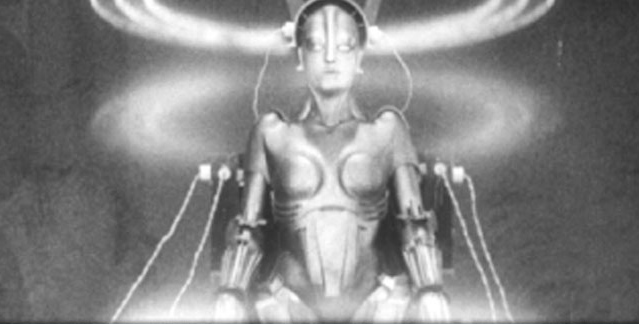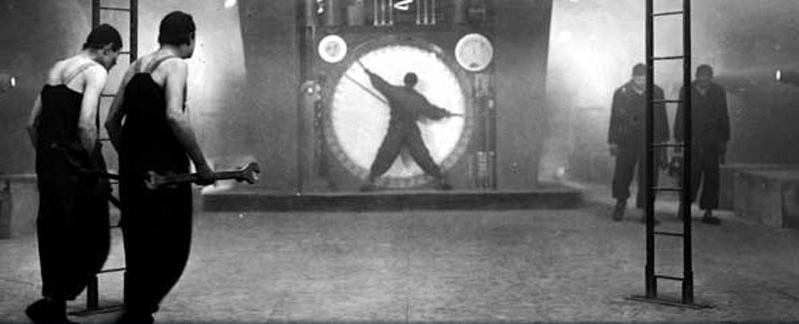The best film of the year is easily the newly restored version of Fritz Lang’s science-fiction masterpiece, METROPOLIS which features twenty- five minutes of missing footage that hasn’t been seen since the movie had it’s premiere in Berlin, 83 years ago. This new footage restores important subplots and makes it clear just how badly METROPOLIS had been butchered by Paramount when they “improved” it for American audiences.
Unfortunately, while the beautifully restored Metropolis is showing at theatres around the country this summer, it appears that in most cities it will be projected at the sound speed of 24 frames per second, even though there is much evidence to suggest the film should be shown at 20 frames per second. In 2001, Enno Patalas of the Munich Film Archive showed a previously restored version of the film at The San Francisco Film Festival and Festival director Peter Scarlet noted, “Metropolis runs 147 minutes at its proper projection speed of 20 frames per second.” Likewise, cameraman Gunther Rittau in discussing the stop-motion effects used for creating the cityscape of Metropolis provides figures that indicate the film should be shown at 20 frames per second. It also seems probable that Lang shot the movie at a frame rate between 18 and 20 fps.
Apparently the main reason the film was transferred to DVD and is currently being shown at 24 frames a second is due to notations on the original score by Gottfried Huppertz. However, according to Stefan Drossler, the current head of the Munich Film Museum, silent films in Germany were routinely shown at frame rates much higher than they were shot at, and projectionists even had to be warned about “speed limits.” Martin Koerber who oversaw the current restoration of Metropolis says, “The premiere of the film took place at the Ufa-Palast am Zoo in Berlin, on January 10, 1927. At the time, the length of the film was 4,189 meters: at a projection speed of 24 frames per second (we can only guess at this today), meaning the showing lasted 153 minutes. …The actual projection speed for the premiere is unclear. Noted on the deleted piano accompaniment for the shortened version is a projection speed of 28 frames per second.”
With such confusion surrounding the proper projection speed, a simple viewing of the film at 24 fps indicates many of the chase sequences and characters appear to be moving too quickly. When seeing Metropolis at the slower rate of 20 fps the characters movements appear much more natural.
However, Metropolis at any speed is a real treat to see up on the big screen, in a print that makes the film look absolutely gorgeous, excepting the 25 minutes of badly damaged 16mm footage that has now been carefully inserted into the film. To celebrate, here is Fritz Lang talking about Metropolis with his friends, Willy Ley, Tonio Selwart and Herman G. Weinberg as recorded and transcribed by Gretchen Weinberg and published in Cahiers Du Cinema in 1965.
Fritz Lang places his hands on the coffee table, while looking at a series of photos from Metropolis spread out before him.
FRITZ LANG: Do you know that there is a shot of my hands in each of my films? Ah, here is Brigitte Helm in Metropolis. God, she’s beautiful! You know, Metropolis was born from my first sight of the New York skyscrapers in October 1924, before I went to Hollywood where UFA was sending me to study American methods of production. It was terribly hot at that time. While visiting New York I felt it was the crucible of the multiple and confused human forces, with blind men scrambling around in the irresistible desire to exploit one another, thus living in perpetual anxiety. I spent an entire day walking the streets. The buildings seemed to be a vertical veil, very light and scintillating, a luxurious backdrop suspended from the gray sky to dazzle, distract and hypnotize. At night the city gave only the impression of living; it lived as illusions do. I knew that I must make a film of all these impressions. On returning to Berlin, in a burst of energy, Thea von Harbou (Lang’s wife) started to write the script. We imagined, she and I, an idle class living in a great city thanks to the subterranean work of thousands of men on the verge of rebellion, led by a daughter of the people. To prevent this rebellion the head of the city asks a scientist to invent a robot in the image of the girl in question. So the robot, Maria, turns against her people and incites the workers to destroy the machine that is the heart of the city, which controls it and gives it life. I have often said that I did not like Metropolis and this is because I can’t accept today the leitmotif of the message of the film. It is absurd to say that the heart is the intermediary between the hands and the brain, that is, of course, between the employee and the employer. The problem is social and not moral. Naturally, during the shooting of the film, I liked it, if I hadn’t I couldn’t have continued to work on it. But later I started to understand what didn’t work. I thought, for example, that one of the faults was the way I had shown the work of the man and the machine together. You remember the clocks and the man who works in harmony with them? He became, so to speak, a part of the machine. Well, that seemed to be too symbolic, too simplistic in its evocation of what is called “the evils of mechanization.” Now, several years ago, I had to revise my judgment again at the sight of our astronauts in their promenade around the world. They were scientists but still prisoners of the space capsule, nothing else—almost a part of the machine that was carrying them.
Lang looks at more photos from Metropolis: the children fleeing the flooded underground city, the robot Maria, the revolt of the workers in the chamber of the machine and the immense stadium used by the children of the ruling class.
FRITZ LANG: See, here’s a shot by Shufftan, it’s Eugene Shufftan who did it. You asked me, Willy, what technical problems we encountered. Well, that scene we shot thanks to mirrors. Shufftan scratched the glass on certain parts of the mirror; then he placed it facing the camera lens so that part of the set–constructed to human scale–appeared in the mirror, which also reflected a miniature set representing the machines in motion. These miniatures extended the real set, because it would have been too costly and too complicated to build for such a short scene. This combination of reality and artifice was then filmed (instead of being done in the lab like it would be now), and that was due to the ingenuity of Shufftan.
Lang looks at a photo of the cityscape of Metropolis.
FRITZ LANG: We constructed a miniature set of the streets about seven or eight feet long, in an old studio with glass walls and we moved the little cars by hand, inch by inch, one frame per movement, filming image by image. We moved the planes and photographed them in the same way. This scene that takes only one or two minutes on the screen took six days to shoot! Ultimately the worse difficulties we encountered were not in the shooting but in the lab. The cameraman had told the technician to develop the film normally. But the head of the lab, knowing the time we had spent filming this short scene, decided to develop it himself. No one had thought it necessary to tell him that for reasons of perspective, the cameraman had filmed the background a little out of focus to give the impression of great distance. The head of the laboratory started to develop the negative focusing the background and not the foreground. The scale of dimensions was then destroyed. I tried to keep my calm. “These things happen, my children,” I said, “Let’s start again.” And we did. (The first thing I discovered about making films is that you never make them alone. Your crew helps you. And I had a remarkable crew.) As for the videophone scene, it was done by projecting a part of the film shot previously in the rear of a telephone apparatus, across a translucent screen, one foot by two. This was the first rear projection and the first transparency. We didn’t realize the importance, the scope of what we had done, for if we had we would have made a fortune patenting a process universally employed today. At the time we only knew that there was a problem that had to be solved. My cameraman, Gunther Rittau, was determined not to fake the shooting; he used his intelligence to arrive at this solution: he synchronized the camera with a projector that was to project the picture of a man on the videophone. That was done with linked rods connected by mobile joints going from the camera to the projector, which were, because of the shooting stage, rather far from each other. Then, when the scene started, the two machines worked at the same time in perfect synchronization. The flooding of the workers city was real, shot in normal scale. Hoses at street level projected water like geysers.

Another camera effect concentrated on creating the robot Maria. The concentric rings of light that surround her and move from top to bottom were in fact a little ball of silver rapidly turning in a circle and filmed on a background of black velvet. We superimposed those shots, in the lab, over the shot of the robot in a sitting position that we had filmed previously.
The city lit up at night was done with an animated drawing. The way we filmed the explosion of the heart machine was one of the first uses of the subjective camera, giving the audience the same impression that the actors feel of the shock. The camera was attached to a swinging pulley on a vertical board that advanced toward the machine on the platform then moved back to give the effect of the explosion.
Sergei Eisenstein visited me in the studio and we had a controversy about the moving camera versus the fixed camera, but we weren’t able to discuss it for long because of my shooting schedule. I planned to see him several days later, but he had already left Berlin and I never saw him again. Someone told me that he did a study on my working methods on the first Dr. Mabuse, which I’m told was published in Russia.
Speaking of camera effects, there are some that can only be done thanks to make-up. For example, in The Testament of Doctor Mabuse, when Doctor Baum meets the ghost of Mabuse at night, he sees on its head the living brain he had dissected that very morning, in order to discover what anomaly had made Mabuse a great criminal. This is how it was done: we had a special skull on which we put glass tubes outlining the form of the brain. The tubes were filled with mercury so the liquid moved whenever Mabuse did. Between the glass tubes the make-up man put bits of white hair, like Mabuse had in real life, which gave the public the impression of seeing his brain through the skin. To enhance the horrible aspect of the spectre, a bit of eggshell was placed over each eye and the cornea was painted in a deformed way.
Lang looks at a photo of Peter Lorre in M.
FRITZ LANG: Peter Lorre. I discovered him for M, you know. I loved him very much. We were friends for 35 years.
[serialposts]
